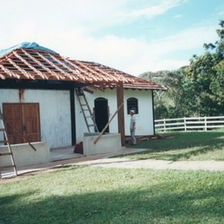
The Monastery of Santa Cruz
On May 3, 1987, six monks from the Monastery of Notre-Dame-du-Barroux established the Benedictine Monastery of Santa Cruz in Nova Friburgo, RJ. Since 1988, the Non-Profit Religious Institution has been actively fulfilling its mission through many collaborative initiatives.
It started in 1963 when Dom Gérard Calvet, a monk from the Abbey of Tournay, arrived in Southern Brazil to help with a Benedictine foundation. Among his many friendships in Brazil, he joined the writer Gustavo Corção for a common purpose. Gustavo Corção had already gained prominence in Brazilian journalism for his writings and early realization of the cultural and religious crisis not only in the world but also in the Rio de Janeiro of his time. This first attempt by Dom Gérard did not go ahead, as Providence had other plans. Dom Gérard returned to France.
Back in France in 1970 and unhappy with the increasingly progressive course of his Monastery, he was authorized to found "ad experimentum," a community in Bédoin, near Avignon: the Priory Sainte Marie-Madeleine. Conditions were difficult, as in any other foundation, but this time the founder's more traditionalist leaning clashed with Modernist Rome regarding doctrine and liturgy. It should be remembered that during the 1970s, a cultural revolution occurred in the secular world, in addition to a "Third World War" unleashed within the Church, imploding altars and demolishing Catholic Tradition.
With only three members, the community of Bishop Gérard providentially came to know Archbishop Marcel Lefebvre, founder of the Priestly Fraternity of Saint Pius X, and immediately received encouragement and help from the Archbishop and his Seminary in Écône, Switzerland. It was the first Benedictine foundation linked to the FSSPX and, after 1988, would remain so until the foundation of the Santa Cruz Monastery.
The old Monastery, sheltered in a medieval structure, was quickly overwhelmed with countless vocations, mainly from the French traditionalist milieus. The Monastery of Bédoin would no longer be able to handle the influx and be suitable for the requirements of a contemplative life. With donations and the help of countless families, Dom Gérard found a new location in Le Barroux, in the south of France.
With the growth of the Monastery of Le Barroux, Dom Gérard decided to make a new foundation outside Europe in Brazil. Driven by old bonds of friendship and having two Brazilians in his community, the continuation of the Benedictine Tradition in Brazil was secured. Among the first Brazilians was Dom Tomás de Aquino, a young man who, on the recommendation of Gustavo Corção, had sought the French religious house to pursue a monastic vocation. Dom Tomás was chosen to supervise and coordinate the installation of the new Benedictine house, the daughter of Le Barroux.
For over 30 years, overcoming many difficulties and challenges, the Monastery has remained. It has sent missions and monks throughout Brazil to spread Catholicism, establish schools, newspapers, publishers, and bookstores, and promote skills such as beekeeping, meliponiculture, and candle-making.
To this day, with fidelity to the Benedictine Monastic Spirit, the work within the Diocese of Campos, first under Bishop Castro Mayer and now Dom Licinio Rangel, has continued, establishing the Monastery of Notre-Dame de Bellaigue in France, which in turn started the Reichenstein Monastery.

Filioli: diligite alterutrum.
Children: love one another.
S. João XV, 17

























